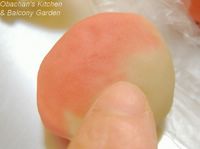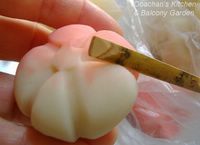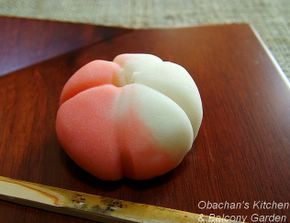Nerikiri Click here for the recipe Nerikiri Ingredients: 350 g Shiro-an (Sweetened white bean paste) 10 g rice flour 12 mL water 10 g white sugar Food coloring * I understand your concern about the food coloring. More and more Japanese confectioners use natural colors of fruits/vegetables to color wagashi these days. They use the juice or knead steamed vegetable into the dough. From what I read online, some use, for example, beets for red color, egg yolk or pumpkin for yellow, matcha for green, purple potatoes for purple, etc. This time I used store-bought red food coloring, but use what you feel comfortable with. If you come up with a good idea, please let me know. Direction:  Heat sweetened white bean paste in a pot over a VERY low heat, stirring vigorously. It’ll turn soft first then somewhat come together, maybe in 4 to 5 minutes?? The paste is done if it does not stick to the skin when you touch it with the back of your hand. * I do not recommend using microwave for this procedure, because once you overdo it, there’s no way to fix it. Plus, you’ll need to use a pot later to heat the dough again anyway, so it'll be easier to start with a pot. Heat sweetened white bean paste in a pot over a VERY low heat, stirring vigorously. It’ll turn soft first then somewhat come together, maybe in 4 to 5 minutes?? The paste is done if it does not stick to the skin when you touch it with the back of your hand. * I do not recommend using microwave for this procedure, because once you overdo it, there’s no way to fix it. Plus, you’ll need to use a pot later to heat the dough again anyway, so it'll be easier to start with a pot. In a microwavable bowl, mix rice flour, water and sugar. Cover with plastic wrap and microwave for apx. 30 seconds. (When I want to make whighter nerikiri dough, I reduce the amount of water a little and stir small amount of egg white into the water before adding it to the bowl.) In a microwavable bowl, mix rice flour, water and sugar. Cover with plastic wrap and microwave for apx. 30 seconds. (When I want to make whighter nerikiri dough, I reduce the amount of water a little and stir small amount of egg white into the water before adding it to the bowl.) Stir well until it turns white, glossy and elastic. This is called gyuhi, which is practically similar to the daifuku skin. Stir well until it turns white, glossy and elastic. This is called gyuhi, which is practically similar to the daifuku skin. Take 20 g of the gyuhi made as above and add to the bean-paste. Keep stirring vigorously over VERY low heat (for 3 to 4 minutes??) until the dough becomes a little softer and more elastic than the bean paste, but not sticking to your fingers. Take 20 g of the gyuhi made as above and add to the bean-paste. Keep stirring vigorously over VERY low heat (for 3 to 4 minutes??) until the dough becomes a little softer and more elastic than the bean paste, but not sticking to your fingers. After the dough cools, keep it wrapped in plastic wrap to prevent it from drying up. After the dough cools, keep it wrapped in plastic wrap to prevent it from drying up.* They say you can freeze this nerikiri dough, but again I’m not sure how long it keeps well in the freezer. When I tried, the dough was perfect when thawed at room temperature after keeping it in the freezer for 1 week. You can color dough with food coloring and play with different color combinations. Be careful not to make the dough too mushy when coloring it. Also you can make the dough into different shapes using molds, cookie cutters, etc. One technique: 1  2 2  Make small balls of shiroan (the yellowish one in the photo), pink-colored nerikiri dough and white nerikiri dough. Wrap an with pink dough. Then wrap the pink dough with thin white dough. Make small balls of shiroan (the yellowish one in the photo), pink-colored nerikiri dough and white nerikiri dough. Wrap an with pink dough. Then wrap the pink dough with thin white dough.3 4  5 5  The pink color should vaguely show through the white skin. Make incisions using knife, fork, spoons, etc. so that the pink color would show in the cuts. My hunch is that something made of wood may be better than metallic utensils. The pink color should vaguely show through the white skin. Make incisions using knife, fork, spoons, etc. so that the pink color would show in the cuts. My hunch is that something made of wood may be better than metallic utensils.6 Another technique:   Put pink and white dough together. Smudge the borderline with a finger.   Flatten the dough and wrap shiro-an ball with it. Shape into a flat ball and smooth the surface.  Make incisions. I used the flat wooden pick that will be included in my wagashi-making kit. Make incisions. I used the flat wooden pick that will be included in my wagashi-making kit.Two types of flowers I made using this method. More techniques for making color gradations are introduced here and here (text is in Japanese only, but the photos are pretty self-explanatory.)  And if you didn’t like what you made, just put everything together and, using plastic wrap like this, squeeze it into a small chestnut or onion shaped ball with an interesting color mixture. ;) And if you didn’t like what you made, just put everything together and, using plastic wrap like this, squeeze it into a small chestnut or onion shaped ball with an interesting color mixture. ;) Categories: Sweets, Wagashi |
Monday, December 11, 2006
Nerikiri Recipe
Posted by
obachan
at
12/11/2006 01:11:00 PM
![]()
Labels: Home-made wagashi
Subscribe to:
Post Comments (Atom)



















23 comments:
I'm going to go buy my ticket! In the meantime, I have a question: is it really 30 minutes for the mochiko in the microwave? That seems so long.
AHHHHHH!!! That's 30 seconds!! I just fixed it. So sorry and thanks for telling me!
Hi there! These are too pretty to put in my mouth! But I seriously wanna try making them! Could u enlighten me on the diff between gyuhi and a daifuku skin? And becos i don't have a microwave, could I place the rice flour mixture over a simmering pan of water instead?
Hi Rika,
Thank you so much for the good question. I honestly don’t know the exact difference between gyuhi and daifuku-mochi skin. Could be the proportion of the ingredients???
About making gyuhi without microwave, I experimented for you, and here’s what I just found:
Double boiler method does not seem to work well. I don’t know why, but the mixture turned out very runny, almost liquid-like, even though I did not let any water get in the mixture while stirring.
An alternative method:
Put rice flour in a bowl, add the same amount of water (if 10 g rice flour, add 10 g water) and knead to make dough. It should feel like your ear lobe or bread dough. Flatten it to make a very thin disk, throw it into boiling water and wait until it floats. Take it out from water and drain. Put it in a saucepan. Stir vigorously with a wooden spatula over a VERY low heat. When it becomes softer and elastic, add 10 g sugar (the same amount as rice flour) in 2 or 3 times, stirring vigorously after each addition, and keep stirring until the dough looks like the one in the photo in my recipe. But if you do it this way, good amount of gyuhi will stick to the saucepan and you probably won’t get 20 g gyuhi out of 10 g rice flour, 10 mL water and 10 g sugar. So you might want to increase the amount of gyuhi ingredients to obtain 20 g gyuhi.
Hope this helps. :)
Hello! I love your site on wagashi. I just have a question, do you know where I can buy online the shir-an in the package? I am from the US and was wondering if I could order it online. When you have time, I hope you would post more wagashi recipes. Thank you.
Hello! Thanks for your interest in my site and especially wagashi.
I googled and found a couple of Japanese sites that sell shiro-an online, but none of them ship products to addresses outside Japan. Sorry.
How about buying raffle tickets and winning my wagashi-making kit? ;)
Hi Obachan! Thanks for going through all the trouble in experimenting! The alternative method reminds me of the directions to make choux pastry. I'll give it a try soon! :D
Good luck, Rika!
A bit late, but I finally attempted to make nerikiri, shiro-an and all: http://beneko.blogspot.com/2008/01/omgwagashi.html
oh and I have a question: how do you make shiro-an less grainy? I removed all my bean seeds by hand but they were strained through a sieve which took a heck of a long time to finish. Would using a suribachi be better?
Hi Hachiko,
I saw the photo of your nerikiri. You did a great job! :D Was it fun to use smudging or see-through technique, or to wring the top of the nerikiri ball wrapped in a piece of plastic wrap?
About making shiro-an, you mean you removed the skins of the beans, right? Actually I have never done it myself so I don't know how easy or hard it usually should be. IIRC, a Japanese woman living in the U.S. wrote on her blog that she used a food processor instead of using a sieve. She didn't even remove the skins, but she said that you can make shiroan with tolerable texture if you process it long enough.(Don't know how long, though.) My hunch is that if you do remove the skins and use a food processor (and then strain it through a sieve, if necesarry),it would be easier??? But sorry, I don't know for sure.
BTW, have you seen this post before? It has a couple of links to very good shiroan recipe sites, so I thought you might be interested.
(;゚Д゚)My bad, I meant beans.
I liked using the see through technique a lot! I was grinning so much since they looked like little peaches. Plastic wrap admittedly, was a bit annoying to use. The bean paste and gyuhi were all over my hands and then I had to spread more koshian bits on something else.
My mum and I were gonna buy a food processor during the day of a big sale, but we forgot while we were in the store. I'll keep that in mind though.
That link is really helpful! thanks a lot!
Wow Thanks for the recipe , I have to bring food to a school-like thing and this will totally get noticed as a dish. It is going to be hard labor for mr but i will try my hardest to make an edible dish that will look nice and represent how tasty Japanese sweets are.
Hi Obachan,
your nerikiri looks fantastic.you make it look so easy.I've tried to follow your recipe,i have encountered some problems. I hope you could help me.
I'd like to know how do you make your nerikiri so white? I've tried putting some egg white on the gyuhi, my nerikiri still looks so yellowish.Is it because of the bean i'm using? or there is something wrong with my shiroan? i'm using white navy bean. However, i found another white lentils which i haven't try yet. i'd like your recommendation please.
and one more question if not too much, if my nerikiri is sticky, what did i do wrong?
Thank you so much for your time!!
Hachiko;
I wonder if you got the food processor. If you got one, I hope you and your mom are having fun using it. :)
Daniel;
Hope you and your friends liked the sweet.
Chama;
My nerikiri was beige, to tell you the truth. The photos are misleading, actually -- they turned out whiter than what they really were. So don't be too discouraged. If you removed the skins from the beans, the paste would look relatively whiter, but still it would look beige, or yellowish beige, not really white-white.
Too sticky nerikiri? Mmmmm... could be too much gyuhi?? I'm not sure... Sorry.
;
is the yellowish ball just plain shiro-an not heated up?
Hi, I was wondering how to shape this into a cat, because my friend is obsessed with cats and japan, though she's Australian! and is it even possible to shape these into more detailed shapes? Please inform me soon! thank you in advance
Hi Anonymous commenter,
I guess you can make cats with nerikiri like you make them with marzipan or playdough.
I don't know how detailed you can make it, but using differently colored nerikiri dough, I guess you can have fun.
Here's some examples...
https://www.google.co.jp/search?q=%E7%B7%B4%E3%82%8A%E3%81%8D%E3%82%8A%E3%80%80%E7%8C%AB&biw=989&bih=435&source=lnms&tbm=isch&sa=X&ved=0CAYQ_AUoAWoVChMIiYDewp_FxwIV5d2mCh0QwwHP
Or if you have cat-shaped cookie cutters, they may help
https://www.google.co.jp/search?q=cookie+cutter+cat&hl=ja&tbm=isch&tbo=u&source=univ&sa=X&ved=0CCEQsARqFQoTCJiVvpWdxccCFUZipgod1jMI3Q&biw=989&bih=435
though I have no idea how much the dough would stick to the cutters, because I've never tried it before...
Good luck and have fun! :D
hi obachan! thank you for your precious posting about nerikiri.
i just have a question. when you heat up the shiro an in a pot at the very low temperature, you said use the skin to check if it's done. but if the shiro-an does not stick on the skin already, even before you put them in the pot, then is there a point to do this procedure? (i mean heating up the shiro an)
OR, in another case, if the shiro-an that you got is so sticky, is it able to get mattified without adding gyuhi?
casue many other nerikiri recipes say that add the dose of gyuhi with shiro-an > and heat up > and check if it's sticky.
Hi Saitosan,
Thanks for your interest in this recipe. Now I have to apologize to you that this is an old post and I don't remember which recipe inspired me to make nerikiri first. But I assume that the process of heating the sweetened white bean paste beforehand was only necessary when it was sticky. If you can get non-sticky white bean paste, I guess you can omit that process.
About the second part of your question:
I think you still need gyuhi because it's not about stickiness -- gyuhi adds elasticity, I think. So I don't think you can omit it.
Hope this answered your question. Thanks! :D
Hi,
Thanks so much for sharing this! I am also curious as to how long can the made nerikiri (final product) be kept/stored? Should it be stored in the chiller or just in room temperature? Thanks! :)
Hi fransisca,
If where you live is very hot and humid like my hometown, nerikiri can get moldy in 3 or 4 days at room temperature in summer. Keeping it in the fridge can prevent that, but it will make nerikiri a little hard and dry on the outside eventually...
So I would say, nerikiri may stay OK for one day at room temp (can't guarantee, though), and maybe 2 to 3 days in the fridge if wrapped properly in plastic wrap. To store it longer, freezing is the best solution. Just thaw it at room temperature several hours before you eat it. I don't know exactly how long it takes... it would depend on the room temperature and the size of the nerikiri, you know.
Hope this helps!
Post a Comment